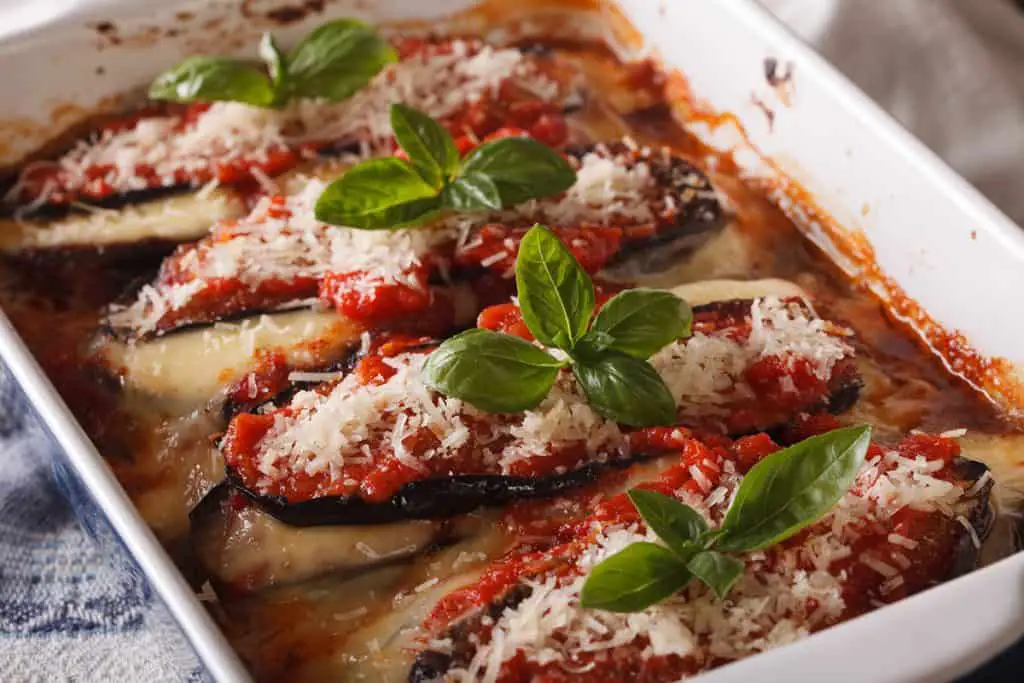How to Freeze Eggplant Parmesan (Prepared but UnBaked)
Besides its use of simple ingredients, eggplant parmesan is fairly easy to cook. All you’ll need to do is prepare and assemble all your ingredients before placing the dredged eggplant in the oven. But can you freeze eggplant parmesan for later consumption?
You can freeze eggplant parmesan for up to 3 months, provided you maintain a 0⁰F (-17⁰C) freezing temperature. For best outcomes, it’s advisable to assemble the dish (without baking) and wrap it in foil tightly. Remove the eggplant parm from the freezer only when you’re ready to bake and eat it.
If you’re still reading, chances are you’re a big fan of eggplant parmesan and want to know the best way to store it. Luckily, we’ve got you covered. Read on for some tips on how to keep this family-favorite meal fresher for longer.
How To Freeze Eggplant Parmesan
Preparing eggplant parm can be a time-consuming affair, as you need to slice and soak the eggplant (to release moisture), set up separate dishes for dredging, and dredge the eggplant before the first round of baking.

As a result, most of us prefer preparing a larger batch of eggplant parmesan and storing the excess for later. In this section, we’ll highlight some tips to observe when freezing eggplant parm.
1. Prepare the Eggplant Parmesan Ingredients As Usual
The whole idea of freezing eggplant is to avoid the cumbersome preparation work, which should allow you to whip up a quick meal after removing the dish from the freezer.
Therefore, you’ll need to prepare all ingredients as usual, as briefly explained below:
- Slice eggplant. Slice 2-3 eggplants (depending on the amount of parmesan you want to prepare) and soak in salt for 40-60 minutes to release the moisture. Use a dry paper towel to dry the slices completely.
- Set up 3 separate dredging dishes. In the first dish, stir ingredients like flour, salt, and pepper. Next is to beat and whisk eggs in the second dish (you may add milk). Stir panko breadcrumbs, garlic powder, and Italian breadcrumbs in the third dish.
- Dredge eggplant slices, one at a time. Once your eggplant slices have soaked and dried up, dip each slice in the dredging stations one at a time. Start by dipping in the flour mixture, then the egg mixture, and finally the bread crumb mixture to give the slices a rich coating.
- Fry/bake the eggplant slices. While some might prefer to fry the eggplant slices using vegetable oils in a skillet, oil-fried eggplant tends to get soggy when frozen, and baking them is much better for long-term freezing. Preheat the oven before preparing your dredging stations. Also, sprinkle some oil to grease the large baking sheet before placing the dredged slices (without stacking).
- Roast the slices. Place the eggplant slices in the preheated oven and allow them to sit for 20 minutes. You can sprinkle parmesan cheese (light coating) on the dredged eggplant slices before sliding them into the oven. Remember to flip the eggplant slices after around 10 minutes to ensure both sides are well roasted.
- Complete the assembling: You can place several teaspoonfuls of marinara at the base of a large enough freezer-friendly glass dish and layer the baked eggplant slices. Drizzle more marinara on top of each of the layered eggplants. Next is to add sliced mozzarella on top of each baked eggplant.
Some people prefer sprinkling some grated parmesan cheese atop the sliced mozzarella before stacking the other dredged slices.
Keep in mind, adding extra ingredients such as fresh basil, isn’t advisable if you plan to freeze your eggplant parmesan for several weeks or months. Instead, only add such ingredients when you’re ready to cook after thawing. This ensures you consume a fresh, tasty dish of eggplant parmesan despite months of being frozen.
2. Allow the Assembled Meal To Cool
Once done assembling your eggplant parmesan, the next step is to prepare it for freezing. It isn’t advisable to freeze hot or warm foods, as this will significantly compromise the quality of the dish once thawed. To ensure your eggplant parm better maintains its texture and flavor, it’s best to give it a few minutes to cool off.
3. Cover the Eggplant Parmesan With Plastic Wrap and Aluminum Foil
After cooling, you’ll need to cover the eggplant parm with plastic wrap. It’s important to create an airtight seal and secure the plastic wrap tightly around a freezer-friendly glass dish.
Then, wrap the top of the dish with aluminum foil for further insulation and protection. It’s also advisable to record the storage date using masking tape before placing it in the freezer.

4. Place the Wrapped Eggplant Parmesan in the Freezer
Once you’ve tightly sealed your eggplant parmesan with plastic wrap and aluminum foil, you can go ahead and place it in the freezer. Remember to maintain freezer temperatures at 0⁰F (-17⁰C) for the most successful outcome.
While your eggplant parmesan can sit in the freezer for several months, it’s best to consume it within 3 months to experience the rich flavor of the ingredients.
5. Remove the Eggplant Parm When Ready To Eat
The main advantage of freezing assembled eggplant parmesan is you won’t have to perform the lengthy task of preparing ingredients as frequently.
Simply remove the parm from the freezer and allow it to thaw inside the fridge (ideally overnight). For best outcomes, you can add a bit of tomato paste and extra parmesan cheese before placing it in the oven for the final round of baking.
After thawing, bake the eggplant parm at 350°F (176°C) for approximately 20-25 minutes, until the cheese melts and becomes brown (and gooey).
Does Freezing Reduce the Quality of Eggplant Parmesan?
Freezing does reduce the quality of eggplant parmesan over time as the freshness of ingredients lessen. You can reduce the pace of deterioration by wrapping the assembled dish in foil to provide an extra layer of protection.
Nonetheless, freezing is a great way to store your eggplant parm for future consumption.
As a good rule, you should not remove the eggplant parmesan from the freezer unless you plan to consume it. Moreover, since most of the ingredients used in eggplant parm can go bad in normal temperatures, it’s best to thaw the meal inside the refrigerator.
Wrapping Up
Eggplant parmesan is a family favorite meal that, although straightforward to cook, requires a considerable amount of time to prepare the ingredients.
As such, it makes more sense to prepare the delicacy in large amounts and store some in the freezer for future use.
And since it’s possible to freeze eggplant parmesan, it’s best to assemble the meal before placing it in the freezer for storage. Your eggplant parm should be fresh and ready for baking when stored in a 0⁰F (-17⁰ C) freezer for 2-3 months.



